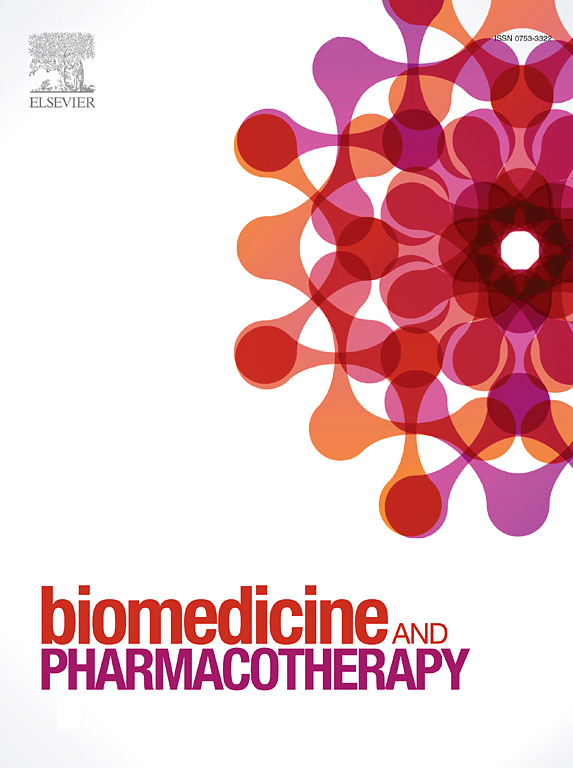制备和评估负载有葛根素的聚乳酸(PLGA)纳米颗粒以提高 SD 大鼠的口服生物利用度
IF 6.9
2区 医学
Q1 MEDICINE, RESEARCH & EXPERIMENTAL
引用次数: 0
摘要
背景:葛根素(Pue)是一种异黄酮化合物,对心血管疾病有显著疗效,但其水溶性差、口服生物利用度低等特点限制了其临床应用:本研究采用乳液溶剂挥发法将 Pue 制备成 PLGA 纳米粒子(Pue-PLGA NPs)。方法:本研究采用乳液溶剂挥发法将 Pue 制备成 PLGA 纳米粒子(Pue-PLGA NPs),并对 NPs 的形态、粒度、Zeta 电位、X 射线衍射(XRD)和傅立叶变换红外(FTIR)进行了表征。此外,还对其稳定性和体外释放进行了评估。给 SD 大鼠口服 Pue 和 Pue-PLGA NPs,并建立高效液相色谱-串联质谱(LC-MS/MS)方法测定血样浓度,研究 Pue 和 Pue-PLGA NPs 在大鼠体内的药代动力学行为:结果:透射电子显微镜(TEM)观察到的 NPs 呈规则球状,分散均匀。NPs的平均粒径为(167.1±5.26)nm,Zeta电位为(-29.88±2.46)mV,包封率为(83.12%±4.73%),载药量为(7.75%±1.81%)。体外释放结果表明,药物从 NPs 中缓慢、持续地释放,24 h 达到释放平台,累积释放量为(88.55±2.86)%。药代动力学结果表明,Pue-PLGA NPs的AUC0-24、AUC0-∞、Cmax、Tmax、t1/2、MRT0-24和MRT0-∞分别为Pue的2.196倍、1.978倍、1.327倍、1.5倍、1.385倍、3.915倍和3.140倍。相对生物利用度为(197.82±25.28)%:这些结果表明,所制备的纳米颗粒粒径小、包封率高、载药量大、缓释效果好,能显著提高 Pue 在大鼠体内的口服生物利用度。本文章由计算机程序翻译,如有差异,请以英文原文为准。
Preparation and evaluation of Puerarin-loaded PLGA nanoparticles for improving oral bioavailability in SD rats
Background
Puerarin (Pue) is an isoflavone compound with significant therapeutic effect on cardiovascular diseases, but its poor water solubility and low oral bioavailability limit clinical application.
Methods
In this study, Pue was prepared into PLGA nanoparticles (Pue-PLGA NPs) by emulsion solvent volatilization method. The morphology, particle size, Zeta potential, X-ray diffraction (XRD), and fourier transform infrared (FTIR) of the NPs were characterized. Additionally, their stability and in vitro release were evaluated. SD rats were orally administered wtih Pue and Pue-PLGA NPs, and a high performance liquid chromatography-tandem mass spectrometry (LC-MS/MS) method was established to determine the concentration of blood samples and to investigate the pharmacokinetic behaviour of Pue and Pue-PLGA NPs in rats.
Results
The NPs were observed by transmission electron microscopy (TEM) as regular spheroids and uniformly dispersed. The average particle size of the NPs was (167.1±5.26)nm, the Zeta potential was (-29.88±2.46)mV, the encapsulation rate was (83.12 %±4.73 %) and the drug loading capacity was (7.75 %±1.81 %). The results of in vitro release showed that the drug was released slowly and continuously from the NPs, reaching the release platform in 24 h, and the cumulative release amount was (88.55±2.86) %. The pharmacokinetic results showed that the AUC0–24, AUC0-∞, Cmax, Tmax, t1/2, MRT0–24 and MRT0-∞ of Pue-PLGA NPs were 2.196, 1.978, 1.327, 1.5, 1.385, 3.915 and 3.140 times of Pue, respectively. The relative bioavailability was (197.82±25.28) %.
Conclusion
These results indicated that the prepared nanoparticles had small particle size, high encapsulation rate, drug loading capacity and good slow-release effect, and could significantly improve the oral bioavailability of Pue in rats.
求助全文
通过发布文献求助,成功后即可免费获取论文全文。
去求助
来源期刊
CiteScore
11.90
自引率
2.70%
发文量
1621
审稿时长
48 days
期刊介绍:
Biomedicine & Pharmacotherapy stands as a multidisciplinary journal, presenting a spectrum of original research reports, reviews, and communications in the realms of clinical and basic medicine, as well as pharmacology. The journal spans various fields, including Cancer, Nutriceutics, Neurodegenerative, Cardiac, and Infectious Diseases.

 求助内容:
求助内容: 应助结果提醒方式:
应助结果提醒方式:


